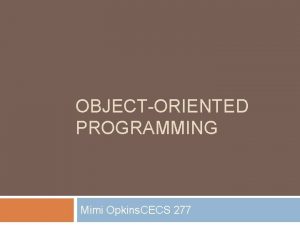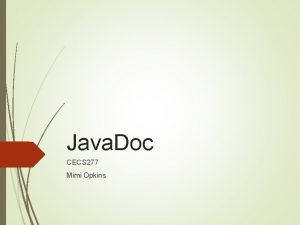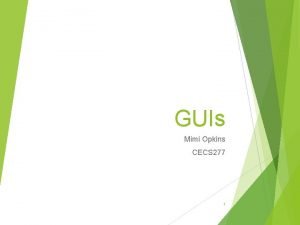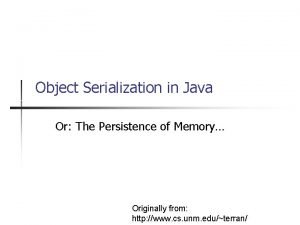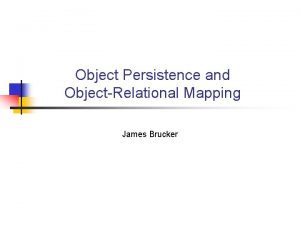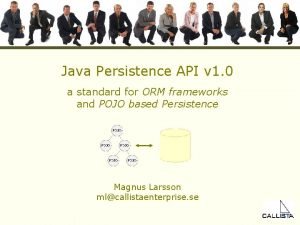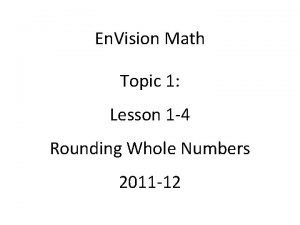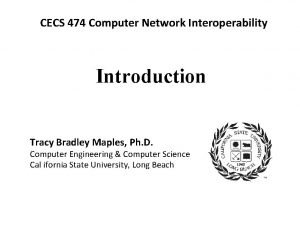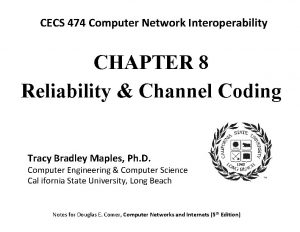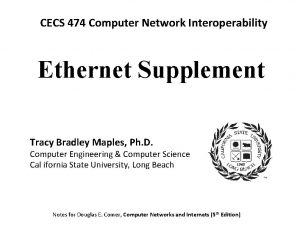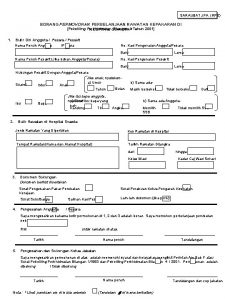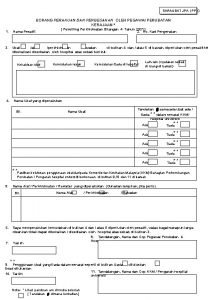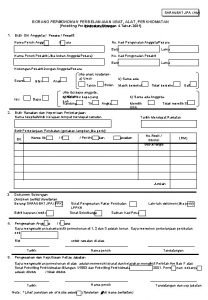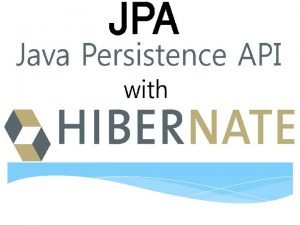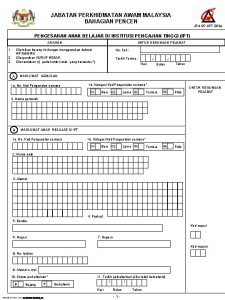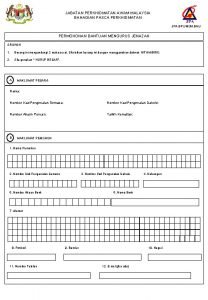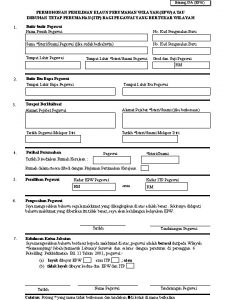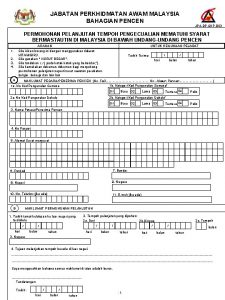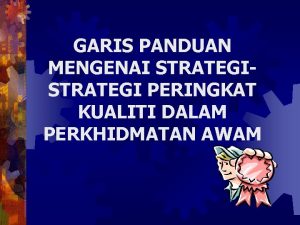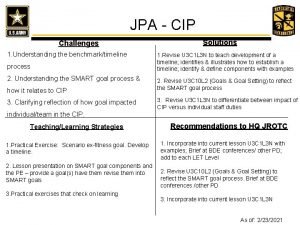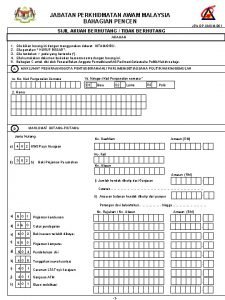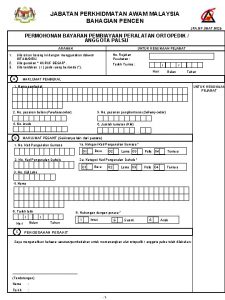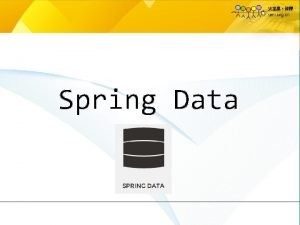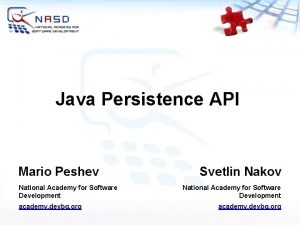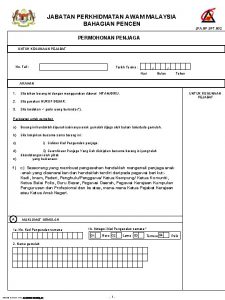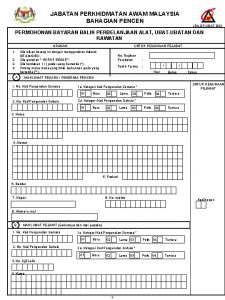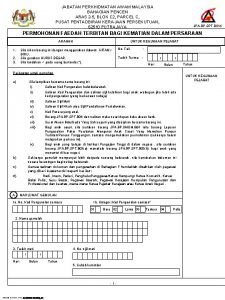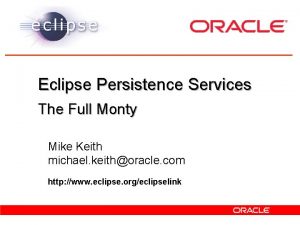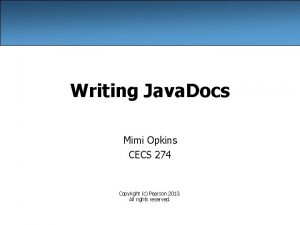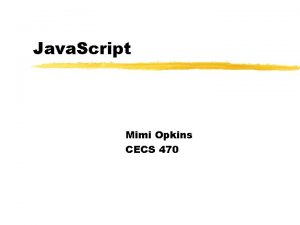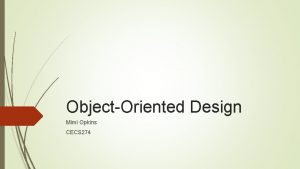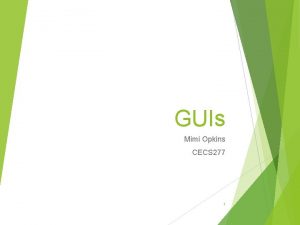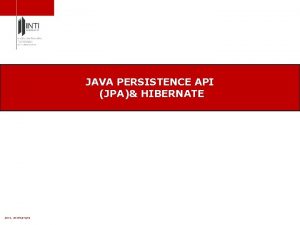Java Persistence Architecture JPA Mimi Opkins CECS 493



















































![Customer Entity Class-A class that inserts a record 52 public static void main(String[] args) Customer Entity Class-A class that inserts a record 52 public static void main(String[] args)](https://slidetodoc.com/presentation_image/5c16f24a6310e404b07ff494d851d16b/image-52.jpg)











- Slides: 63

Java Persistence Architecture (JPA) Mimi Opkins CECS 493 Fall 2016

Using the Java Persistence Architecture You may have seen how to access a database with JDBC. Nowadays, many programmers prefer to use an object/relational (O/R) mapper rather than raw SQL commands. The Java Persistence Architecture (JPA) provides a standard O/R mapper for the Java EE technology stack.

A Crash Course in JPA An O/R mapper translates between database tables and Java objects that you manipulate in your program. Your program never touches the database directly. In JPA, you use annotations to mark the classes that should be stored in the database. (These classes are called entities. ) For example, here is a Credentials class with the requisite annotations:

Entity Requirements For a class to be an entity, there are three requirements: 1. The class must be annotated with @Entity. 2. Each object must have a unique primary key, marked with the @Id annotation. 3. The class must have a default constructor. You use additional annotations to denote relationships between entities. For example, here is how you express the fact that each Person has one associated Credentials entity and zero or more associated roles: The O/R mapper translates these annotations into foreign keys or join tables.

Entity Mapper You use an entity manager to create, read, update, and delete entity objects. The following call adds a new entity to the database: Entity. Manager em =. . . ; em. persist(entity); To change an existing entity, modify the Java object and commit the current transaction. The changes are automatically saved. You remove an entity by calling em. remove(entity).

JPQL To read data, you issue a query in JPQL, an object-oriented query language that is similar to SQL. For example, the following query finds the Credentials objects for a given username: SELECT c FROM Credentials c WHERE c. username = : username The colon indicates a parameter that should be set when issuing the query. Here is how to get the query results:

Behind the Scenes We use a @Suppress. Warnings annotation because the get. Result. List() method returns a raw List, and that list is assigned to a parameterized List<Credentials>. We want a list with the appropriate type parameter so that we can get the elements as Credentials objects. Behind the scenes, the entity manager issues an SQL query, constructs Credentials objects from the result (or finds them in its cache), and returns them in a list.

Using JPA in a Web Application When using JPA in a web application, you need to deal with two issues: 1. Obtaining an entity manager 2. Handling transactions Both of these issues are much simpler when you use an EJB session bean. To get an entity manager, you first obtain an entity manager factory, which the JSF implementation will inject into a managed bean. Place this annotated field into the managed bean class: @Persistence. Unit(unit. Name="default") private Entity. Manager. Factory emf; “Persistence units” are configured in an XML file: jpa/src/java/META-INF/persistence. xml Each unit has a name (here, "default"), a data source, and various configuration parameters. You obtain an entity manager by calling: Entity. Manager em = emf. create. Entity. Manager(); When you are done with the entity manager, call: em. close();

Transactions In a request scoped managed bean, you can inject an entity manager directly. This is not feasible for other scopes because the entity manager is not threadsafe. However, the entity manager factory is threadsafe. You should wrap any work with the entity manager into a transaction. Obtain a transaction manager with the injection: @Resource private User. Transaction utx; Then use this outline:

Directory structure of the JPA demo application Our example program uses JPA to access the database instead of SQL.

jpa/src/java/com/corejsf/Credentials. java

jpa/src/java/com/corejsf/User. Bean. java

jpa/src/java/META-INF/persistence. xml

Using Managed Beans and Stateless Session Beans We now move to a full EJB architecture where the JSF managed beans communicate with stateless session beans, objects that are managed by the application server. There is a significant benefit: By default, session bean methods are automatically transactional. The application server takes care of the transaction handling whenever a session bean method is invoked. Similarly, the application server takes care of threading, simply by providing a pool of beans and issuing one for each request. The beans are called stateless because they should keep no state between requests. That feature enables the application server to pick any available bean for a particular request, or to create new ones when needed.

Stateless Session Bean A stateless session bean is annotated with @Stateless. You inject an entity manager and simply use it, without declaring any transactions: Then inject the stateless session bean into one or more managed beans with the @EJB annotation:

Entity Objects This is a very straightforward programming model. You place the application logic into the managed beans and the business logic into the stateless session beans. The only drawback is that you need to transport a fair amount of data between the two types of beans. You can use entity objects instead, but you have to be aware of a significant restriction. When an entity object is returned from a stateless session bean to a JSF managed bean, it becomes detached. The entity manager no longer knows about the object. If the managed bean changes the entity, it must merge it back into the entity manager. That is usually achieved by a call to another session bean method, which calls em. merge(entity).

Detached Entities Detached entities have another issue. When an entity holds a collection of other entities, that collection is not a simple hash set or array list, but by default a lazy collection that only fetches elements on demand. If you want to send such an entity to a JSF managed bean, you need to ensure that the dependent entities are prefetched, usually by adding fetch instructions in the JPQL query. If you use stateless session beans in your JSF application, you need to learn enough about EJB 3 entities to solve these issues. You can avoid this issue by using stateful session beans. We continue our sample application, now implementing the same functionality with a managed bean and a stateless session bean.

slsb/src/java/com/corejsf/User. Bean. java

slsb/src/java/com/corejsf/Credentials. Manager. java

Stateful Session Beans A stateless session bean is essentially a place to put one or more methods—it is a rather degenerate object. The EJB architecture also defines stateful session beans, which can hold state, just like regular Java objects. Of course, stateful session beans are much more heavyweight. The EJB container manages them, perhaps caching them or moving them to another server for load balancing. The container also provides for access control and transaction support when methods are invoked. With CDI, your application can be composed of stateful session beans and entity beans, both managed by the EJB container. The JSF pages reference stateful session beans directly. Then the issue of detached entities goes away, and it becomes very simple to access the database from your web application. Of course, you are now relying on the EJB container to manage all your beans. For a simple single-server application, this is a significant overhead, even though EJB containers have become lighter weight and faster than they used to be.

Here is how you use a stateful session bean with JSF: • • • In the JSF page, you use #{user. name} and #{user. login} in the usual way. Our sample application has now become extremely simple. The stateful session bean interacts with the JSF pages and the database. The use of JPA has eliminated cumbersome SQL. Transaction handling is automatic.

sfsb/src/java/com/corejsf/User. Bean. java

Persistence API The Java Persistence API (JPA) was introduced as part of the Java EE 5 platform. Its goal is to facilitate data acquisition from relational databases without the complexity of numerous sql statements. The idea is to use an object oriented approach to data storage. Data is handled without the need to create deployment descriptors. Instead annotations are used which are read by the container.

Java Transaction API-JTA The Java Transaction API (JTA) is part of the J 2 EE platform. The API gives you the ability to perform distributed transactions, that is, an application can use the API to perform transactions on more than one data store in the network at the same time. But to do this efficiently, it helps to have another component operating in the application server: a J 2 EE transaction manager. A transaction manager helps to efficiently schedule and execute the potentially large number of transactions coming in through the application server.


26 Java Transaction API The data source must be registered on the server and is specified using the JNDI name. Transactions can be: Container Managed Application Managed. If the transactions are container-managed JTA transactions, the data source must be a JTA data source. This is the preferred way. It must be specified in the descriptor file persistence. xml

27 Java Transaction API If the transactions are application-managed, the data source is specified according to the JDBC database connection registered with the IDE. You use this approach if you are not deploying in a EE container (like Glass. Fish).

28 Persistence API-Entities Entity A table in a database. An Entity is represented by a class Instance of entity corresponds to a row in the database. A number of rules cover the implementation of an entity class. Note: The database is sometimes referred as: Data Source or Data Store

29 Persistence API-Entity Relationships are the same as relationships between tables in a database: One-To-One: Each instance of the entity (row) is related to single instance of another entity (to a single row of another table). One-To-Many: An entity instance can be related to more than one instance of another entity. But an instance of the other Entity can only relate to one instance of the first.

30 Persistence API-Entity Relationships Many-To-One: Multiple instances (rows) of an Entity can be related to one instance of another Entity. But an instance of the other Entity can relate to only one instance of the first Entity. Many-To-Many: An instance of one Entity relates to many instances of another Entity and vice versa. For every relationship there is an owning side and inverse side. The relationship can be unidirectional –it has only an owning side. Or, bidirectional – it ha s both an owning side and an inverse side.

31 Example Relationships Owner Authors Inverse Titles Inverse Many To Many Inverse bidirectional One-To-Many Bidirectional Owner Publisher s

32 Persistence API-Entity Class The class has instance variables The class has accessor and mutator methods that follow the Java Beans convention for naming the methods. The persistent state can be accessed either through the instance variables or through the getter methods (accessors). Persistent Fields (if fields are mapped with annotations) Persistent Properties (if getter methods are mapped with annotations) This is done through annotations to one or the other but not both in a class.

33 Persistence API-Entity Class Annotations are handled by package javax. persistence Fields annotated with Transient are not persisted (saved). Annotations apply to other parts of the program i. e. The class needs to be annotated with the @Entity annotation. The type of relationship needs to be annotated with @One. To. One for example. Other annotations apply to different parts of the class.

34 Persistence API-Entity Class Every Entity must have a unique primary key field that enables clients to locate instances (rows) of an Entity. Primary Keys can be: simple (consisting of a single field) or Composite (consting of one or more persistent field)s and or properties) Composite primary keys are represented by a primary key class.

35 Persistence API-Entity Class Entities support: Inheritance. An Entity class can inherit a non Entity class and a non Entity class can inherit an Entity class. The non Entity classes can have persistent states information (annotations on their fields or properties). If , however, the non Entity class is a super class, it has no persistent state as such. Polymorphism. You can have an abstract Entity class and subclasses of the abstract Entity class that implement parts of the abstract class in different ways each. Association (using another class by instantiating an object of that class).

36 Persistence API-Entity Inheritance Strategies Single Table of the database per class hierarchical inheritance. A Table of the database per concrete Entity class. A “Join” strategy Fields/properties of a subclass are mapped to a different table than the super class.

37 Persistence API-Entity Management There is an Entity Manager object represented by an instance of: javax. persistence. Entity. Manager Each manager object is associated with a persistent context (scope). Each manager object: Removes persistent entity instances. Finds Entities by using the primary key. Allows queries to be run on Entities.

38 Persistence API-Entity Management An Entity Manager can be: Container-managed in which case it (persistence) propagates to all application components (EJBs) with a single Java Transaction Architecture (JTA) transaction via a special annotation. Application-managed in which case the persistence does not propagate to other applications (EJBs).

39 Persistence API-Persistence Units Persistence Unit defines all Entity classes that are managed by Entity. Manager instances within an application. A name should be provided to describe the Persistence Unit in your application. A Persistence Unit is defined in the persistence. xml configuration file. Location of the file within the application in the server varies depending dependent on if the client is a client application or a web application. The IDE will place it in the proper directory.

40 Persistence API-Entity Class Assume you have a CUSTOMER table, whose schema is represented by the table in the next slide.

Customer Table Example 41 NAME PK? TYPE NULL? CUST_ID Y INTEGER NOT NULL FIRST_NAME VARCHAR(50) NOT NULL LAST_NAME VARCHAR(50) STREET VARCHAR(50) APPT VARCHAR(20) NOT NULL CITY VARCHAR(25) ZIP_CODE VARCHAR(10) NOT NULL CUST_TYPE VARCHAR(10) NOT NULL LAST_UPDATED _TIMESTAMP NOT NULL

42 Customer Entity Class import javax. persistence. *; import java. io. Serializable; import java. util. Date; @Entity(name = "CUSTOMER") //Name of the entity if name is different than the class ‘ name then us e@Table annotation. public class Customer implements Serializable { private long cust. Id; private String first. Name; private String last. Name; private String street; private String appt; private String city; private String zip. Code; private String cust. Type; private Date updated. Time; // Getters and setters go here. . . . . }

43 Customer Entity Class The Customer entity needs to know how to map the attributes (or properties) to the CUSTOMER table. Through JPA annotations. Let us use Field persistence:

Customer Entity Class 44 import javax. persistence. *; import java. io. Serializable; import java. util. Date; @Entity(name = "CUSTOMER") //Name of the entity public class Customer implements Serializable { @Id //signifies the primary key @Column(name = "CUST_ID", nullable = false) @Generated. Value(strategy = Generation. Type. AUTO) private long cust. Id; // 3 annotations define the field cust. Id as a primary key. //@Generated. Value signifies a strategy to assign a unique value to your identity fields automatically. //The types of strategies available are IDENTITY, SEQUENCE, TABLE, and AUTO.

Customer Entity Class 45 @Column(name = "FIRST_NAME", nullable = false, length = 50) private String first. Name; @Column(name = "LAST_NAME", length = 50) private String last. Name; // By default column name is same as attribute name private String street; @Column(name = "APPT", nullable = false) private String appt; // By default column name is same as attribute name private String city; @Column(name = "ZIP_CODE", nullable = false) // Name of the corresponding database column private String zip. Code;

46 Customer Entity Class @Column(name = "CUST_TYPE", length = 10) private String cust. Type; @Version @Column(name = "LAST_UPDATED_TIME") private Date updated. Time; //@Version signifies a version field in an entity. JPA uses a version field to detect concurrent modifications to a data store record. When the JPA runtime detects multiple attempts to concurrently modify the same record, it throws an exception to the transaction attempting to commit last. This prevents you from overwriting the previous commit with stale data. // Getters and setters go here. . . . . }

47 Customer Entity Class-xml file An descriptor file called persistence. xml is needed to describe the persistence unit (database). <? xml version="1. 0"? > <persistence> <persistence-unit name="testjpa" transaction-type="RESOURCE_LOCAL"> <provider> org. apache. openjpa. persistence. Provider. Impl </provider> <class> entity. Customer </class> <properties> <property name="openjpa. Connection. URL" value="jdbc: derby: //localhost: 1527/D: Open. JPADerbyMy. Customer; create=true"/>

48 Customer Entity Class-xml file <property name="openjpa. Connection. Driver. Name" value="org. apache. derby. jdbc. Client. Driver"/> <property name="openjpa. Connection. User. Name" value="admin"/> <property name="openjpa. Connection. Password" value="admin"/> <property name="openjpa. Log" value="SQL=TRACE"/> </properties> </persistence-unit> </persistence> Note: openjpa is proprietary to open. Source version.

49 Customer Entity Class-xml file Another version of the. xml file that will apply to Glass. Fish is: <persistence> <persistence-unit name= "testjpa“> <jta-data-source>jdbc/My. Customer</jta-data-source> <jar-file>Nameof. Jar. jar<jar-file> <class>path 1. path 2. Customer</class> </persistence-unit> <persistence> The data source (data base uses JTA – Java Transaction API) Class describes the entity class (or classes if more than one)

50 Customer Entity Class-xml file Notice that: persistence. xml can have multiple persistence units. Each unit can be used by different JPA vendor or can be used to persist to different databases. The vendor-specific persistence provider name is specified in the <provider> tag. The entity class names are specified in the <class> tag. The database connection properties can be specified within the <properties> tag. Note that the property name will differ for each vendor.

51 Customer Entity Class-xml file In the open. Source version of the persistence. xml the transaction was defined as an application managed transaction via : transaction-type="RESOURCE_LOCAL“ You can do the same in Net. Beans if you want the application to manage the transaction. In the Net. Beans version we indicated that the transaction was container managed. jdbc/My. Customer was the name of the JTA data source (same name was used in the open. Source version).
![Customer Entity ClassA class that inserts a record 52 public static void mainString args Customer Entity Class-A class that inserts a record 52 public static void main(String[] args)](https://slidetodoc.com/presentation_image/5c16f24a6310e404b07ff494d851d16b/image-52.jpg)
Customer Entity Class-A class that inserts a record 52 public static void main(String[] args) { Entity. Manager. Factory entity. Manager. Factory = Persistence. create. Entity. Manager. Factory("testjpa"); Entity. Manager em = entity. Manager. Factory. create. Entity. Manager(); Entity. Transaction user. Transaction = em. get. Transaction(); user. Transaction. begin(); Customer customer = new Customer(); customer. set. First. Name("Charles"); customer. set. Last. Name("Dickens"); customer. set. Cust. Type("RETAIL");

53 Customer Entity Class-A class that inserts a record customer. set. Street("10 Downing Street"); customer. set. Appt("1"); customer. set. City("New. York"); customer. set. Zip. Code("12345"); em. persist(customer); user. Transaction. commit(); em. close(); entity. Manager. Factory. close(); }

54 Customer Entity Class-A class that inserts a record The work of the Persistence class is pretty simple: Persistence is a bootstrap class that is used to obtain an Entity. Manager. Factory In the classpath resources, the Persistence class searches for javax. persistence. spi. Persistence. Provider files in METAINF/services/directory. It reads the Persistence. Provider implementation class names from each file. It then calls create. Entity. Manager. Factory() on each Persistence. Provider with the persistence. Unit. Name until it gets an Entity. Manager. Factory back that isn't null.

55 Customer Entity Class-A class that inserts a record Entity. Manager. Factory is a factory for creating an Entity. Manager. Factory should be cached and should ideally be called once for each persistence unit name in the whole application. Entity. Manager manages entities; it is responsible for their addition, updating, and deletion. The transaction is committed when the transaction object user. Transaction invokes comit.

56 Customer Entity Class-finding a record Finding a record with a primary key is as simple as Open. JPAEntity. Manager oem = Open. JPAPersistence. cast(em); Object obj. Id = oem. get. Object. Id(customer); Customer cust = em. find(Customer. class, obj. Id); //where em is the Enity. Manager object //customer is the Customer object //Because the primary key is unknown up front, the application must cast Entity. Manager to Open. JPAEntity. Manager to get the primary key object by passing the customer object that was persisted earlier. This logic might differ for other vendors.

57 Customer Entity Class-finding a record A more generic approach that can relate to Glass. Fish better is : @Persistence. Context Entity. Manager em; //instead of Open. JPAEntity. Manager public void find. Customer(int cust. ID) { Customer cust=em. find(Customer. class, cust. ID); ……………

58 Customer Entity Class-A Composite Primary Key Assume that the CUSTOMER table doesn't have a CUST_ID field, but that FIRST_NAME and LAST_NAME together make up the primary key. You need to create a separate class, generally called an identity class, with attributes the same as the IDs; then you reference the identity class in the entity class.

59 Customer Entity Class-A Composite Primary Key public final class Customer. Id implements serializable{ public String first. Name; public String last. Name; //default constructor //accessor/mutator methods // override equal() method //override hascode() method . . . . } The identity class can be a separate class or an inner class. If the class is an inner class, it must be static and should be referenced in the entity class.

60 Customer Entity Class-A Composite Primary Key @Entity @Id. Class(Customer. Id. class) public class Customer implements Serializable{ @Id @Column(name = "FIRST_NAME", nullable = false, length = 50) private String first. Name; @Id @Column(name = "LAST_NAME", length = 50) private String last. Name; @Column(name = "APPT", nullable = false) private String appt; . . . .

61 Customer Entity Class-A Composite Primary Key The entity class is annotated with the annotation: @Id. Class to specify the primary key class (identity class) in the entity class Another possible annotations is: @Embeddable Which will be used on the identity class.

62 Difference Between @Id. Class and @Embeddable Annotations Notice that when the @Id. Class annotations is used the fields in the identity class match the fields in the entity class. When @Embeddable is used as the annotation in the identity class we have : @Embeddable public final class Customer. Id implements serializable{ public String first. Name; public String last. Name; //accessor/mutator methods // override equal() method //override hashcode() method . . . . }

63 Difference Between @Id. Class and @Embeddable Annotations The entity class does not have to be annotated with @Id. Class instead: @Entity public class Customer implements Serializable{ Customer. Id primary. Key; public Customer() {. . } @Embedded. Id public Customer. Id get. Primary. Key() { return primary. Key; } public void set. Primary. Key(Customer. Id pk) { primary. Key = pk; ……………………………… }
 Dimodium
Dimodium Cecs 343
Cecs 343 Cecs 277
Cecs 277 Opkins
Opkins Mimi opkins
Mimi opkins Opkins
Opkins Mimi opkins
Mimi opkins Mimi opkins
Mimi opkins Mimi opkins
Mimi opkins Jpql
Jpql Object persistence in java
Object persistence in java Object persistence in java
Object persistence in java Object persistence in java
Object persistence in java Dali java persistence tools
Dali java persistence tools Java object persistence
Java object persistence Sda hymnal 493
Sda hymnal 493 Sda hymn
Sda hymn Round 493 295 to the nearest ten thousand
Round 493 295 to the nearest ten thousand 955 rounded to the nearest ten
955 rounded to the nearest ten 632 rounded to the nearest ten
632 rounded to the nearest ten Opkins
Opkins Cecs 323
Cecs 323 Cecs 474
Cecs 474 Cecs 474
Cecs 474 Cecs 343
Cecs 343 Cecs 474
Cecs 474 Cecs 277
Cecs 277 Cecs 277
Cecs 277 Saraubat jpa
Saraubat jpa Borang sara ubat jpa am
Borang sara ubat jpa am Pekeliling sara ubat
Pekeliling sara ubat Kenaikan pangkat secara fleksi
Kenaikan pangkat secara fleksi Jpa weak entity
Jpa weak entity Jpa.bp.spt.b03a
Jpa.bp.spt.b03a Alamat bahagian pasca perkhidmatan jpa
Alamat bahagian pasca perkhidmatan jpa Exit policy jpa
Exit policy jpa Borang jpa (epw)
Borang jpa (epw) Pencen jpa
Pencen jpa Maksud akrab jpa
Maksud akrab jpa Carta proses q
Carta proses q Persistence
Persistence Jpa objectives examples
Jpa objectives examples Bahagian pencen jpa
Bahagian pencen jpa Jpa bahagian pencen
Jpa bahagian pencen 12 tonggak perkhidmatan awam
12 tonggak perkhidmatan awam Jpa pageable
Jpa pageable Jpa pidn
Jpa pidn Eclipse generate jpa entities from database
Eclipse generate jpa entities from database Contoh isi borang bdr
Contoh isi borang bdr Unit pencen jpa
Unit pencen jpa Borang jpa.bp.sppp.b06
Borang jpa.bp.sppp.b06 Eclipse building jpa project
Eclipse building jpa project Mimi dai math
Mimi dai math Mimo teocrito
Mimo teocrito Papa ama a pepe
Papa ama a pepe Mimi kusimama
Mimi kusimama Dunce hat topology
Dunce hat topology Mimigarciah
Mimigarciah Keely kangaroo alphafriends
Keely kangaroo alphafriends Mimi lufkin
Mimi lufkin Mimi chinese restaurant
Mimi chinese restaurant Mimi siku casserole
Mimi siku casserole A bruxa mimi no inverno
A bruxa mimi no inverno Thiolisis
Thiolisis
